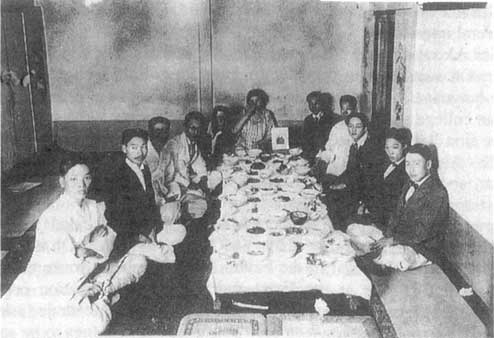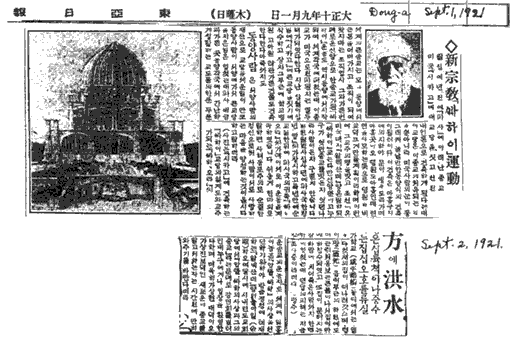
|
|
Abstract:
Bahá'í activities in Korea 1921-1988.
|
Chapter 1PrefaceShoghi Effendi's monumental world-embracing spiritual crusade, commencing in 1953, was destined to take the Bahá'í Faith to all the remaining countries and island sovereignties which the Faith of Bahá'u'lláh had not yet reached. The Ten Year Crusade, as it was called, ended in success and coincided with the first World Congress in London in 1963. During the Ten Year Crusade the Guardian assigned certain areas of the world to the then-existing National Spiritual Assemblies. The Assemblies were to supply the areas with pioneers and to give whatever assistance was needed to establish the Faith.Korea was assigned to the National Spiritual Assembly of the Bahá'is of the United States as a consolidation goal. In 1953 Korea already had some resident Bahá'ís but the Faith was a long way from being firmly established. The first resident Bahá'ís in that difficult post-war period were young men in the United States Armed Forces. Due to the dedication and determination of those young men, who were praised by the Guardian, the Faith became established with Koreans declaring their belief in Bahá'u'lláh. The title of this book is taken from words written by 'Abdu'l-Bahá in a Tablet to Miss Agnes Alexander shortly before His passing. He hoped that "in Korea thou wilt raise the banner of the Greatest Guidance." We must express our deep appreciation to Hand of the Cause Miss Agnes B. Alexander for her carefully preserved documents, papers, letters, etc. Much of the material in this book came directly from her collection, which is held in the National Bahá'í Archives of Japan. Miss Alexander, as an Auxiliary Board Member from April 1954 to March 1957, and after that as a Hand of the Cause, was in touch with the pioneers in Korea, some of whom sent detailed reports. She also visited Korea several times in the 1920s and 1950s. The transliteration of Korean names was a cause of slight difficulty. Rather than attempt to follow a uniform transliteration, the compiler has written the names as they appeared in letters, reports, photographs, etc., and as the individuals themselves wrote their names, with preference for the latter way, though a few inconsistencies remain.
IntroductionKorea was under Japanese rule from 1910 to 1945. In the aftermath of World War II, Korea was divided into northern and southern political and military zones. In 1947 South Korea held a national election and in 1948 the Republic of Korea was formed. It is in South Korea that the Faith has flourished.In 1960 the population of South Korea numbered nearly 25 million. By 1970 it had climbed to about 31.5 million. In 1990 the population was 42 million. The land area, including off-shore islands, comprises about 99,000 square kilometers. Although the influence of Chinese civilization has been great over many centuries, Korea has a distinct language, script, and culture. Among the major religions, Buddhism is followed by about 20% of the population and Christianity by about 20%. 1. The First Mention of the Bahá'í Faith in KoreaIn one of His Tablets to North America (1916) 'Abdu'l-Bahá mentioned Korea and advised Bahá'í teachers to go there to teach the Faith. It was not until 1921 that anyone was able to go with that purpose, however.Miss Agnes Alexander, who many years later was to be appointed Hand of the Cause by the Guardian of the Faith, was the first Bahá'í to go to Korea for the purpose of proclaiming the Faith. She was then living in Japan, spending all her energies to promulgate the Bahá'í Faith in that country. 'Abdu'l-Bahá had sent her to Japan originally. She had arrived there in 1914. At certain periods she would return to her home in Hawaii, to come again to Japan after a time had passed. She spent a total of over thirty years devoting her efforts to that country. As she tells the story, in Tokyo in 1920 she became acquainted with a Korean student, Mr. Oh Sang Sun. He had graduated from a Christian Theological School in Japan but still had not found spiritual satisfaction. He was very interested in the Bahá'í Faith and Miss Alexander hoped that he would become the first to take the Faith to his country. But it was not to be. During the 1930s and 1940s M44r. Oh rose to a position of prominence in Korea, becoming its foremost poet. After he was located by the Bahá'ís in the mid-1950s Mr. Oh was again given a chance to become a Bahá'í and participate in the election on Ridván day, 1956, when the first Local Spiritual Assembly of Seoul was to be elected, but he declined saying that he thought it was better for him to remain free. Although he couldn't commit himself to the Faith, he remained a staunch friend of Miss Alexander and the Faith through the years. Miss Alexander decided that she would go to Korea herself, which she was able to do the next year, 1921, for a month from about mid-August to mid-September. Before she went she obtained several letters of introduction: some from the prominent banker, Viscount Eiichi Shibusawa and from Dr. Soetsu Yanagi, artist and potter. These letters provided her with introductions to the highest echelon and she was able to speak to hundreds of people about the Faith and also to put articles in newspapers, including Dong-A Daily -- all this despite the fact that Korea was under Japanese military rule. During her stay she was able to contact Mr. Oh, who had returned to his home country. She also made the acquaintance of Mr. Roe Z.Y. (Roh Chung-il) who had heard of the Faith from Professor and Mrs. Kuntz, Bahá'ís from Urbana, Illinois, U.S.A. In early 1921 Mr. Roe was returning to his native country from England and they were on the same ship. Prof. and Mrs. Kuntz were on their way to Palestine where they were going on a pilgrimage. Mr. Roe became interested in the Bahá'í Teachings and wanted to meet 'Abdu'l-Bahá. When Mr. Roe stopped in Tiberias, he found that
'Abdu'l-Bahá was in the hotel room next to his. 'Abdu'l-Bahá granted Mr. Roe several interviews. Miss Alexander met Mr. Roe in Seoul. It was her hope that Mr. Roe and Mr. Oh would work together to translate a Bahá'í booklet into the Korean language for their people. At the time Mr. Roe was teaching in a Christian college and he hesitated to do anything openly. The first Bahá'í public meeting was held in Seoul, September 1, 1921 with Miss Alexander speaking. She was very surprised at the size of the audience, about 900 men and women sitting cross-legged on the matted floor listening intently. During that month, September, Miss Alexander decided to hold a Bahá'í Feast on the Feast day at the YMCA in Seoul. Mr. Oh invited his friends who were interested in the Faith. Miss Alexander wrote that there was a wonderful spirit at the Feast and that the conversation centered around 'Abdu'l-Bahá, His Station, and daily life. Miss Alexander asked if the attendants would like to write their sentiments and names to be sent to 'Abdu'l-Bahá, which they did. The next night the Korean friends gave Miss Alexander a party and those who had not been present the day before wrote their notes to 'Abdu'l-Bahá, fifteen young men in all from the two nights. A photograph was taken that night. Miss Alexander wrote that it was a heavenly feast and her only sorrow was that there were no women present. She later wrote that the story of Seoul was the greatest story of her Bahá'í life. The letter from the Koreans to 'Abdu'l-Bahá was very significant because He responded with the only Tablet written to Koreans. It was dated November 5, 1921 and arrived after His Passing, reaching Miss Alexander in Tokyo February 14, 1922. At the same time He addressed a Tablet to Miss Alexander dated November 7, 1921. He wrote to her, "Thy letter has been received and gave great joy. Praise be to God that the confirmations of the Kingdom of Abhá reached and thou becamest the cause of guidance of the souls. It is my hope that in Korea thou wilt raise the banner of the Greatest Guidance. Convey my utmost kindness to Mr. Roh [Roe]. I have the utmost love for him and ask for him heavenly blessings." Mr. Roe was the only Korean to gain 'Abdu'l-Bahá's presence, as far as is known, and He sent His "utmost love" and asked for "heavenly blessings" for him. How blessed was Mr. Roe! Unfortunately, Mr. Roe was never able to commit himself to the Faith.
 click for larger image The second of two meetings held in Seoul by Miss Alexander September 8 and 9, 1921. The first meeting was a Bahá'í Feast. Fifteen men total from the two nights wrote their names and brief notes to be forwarded to 'Abdu'l-Bahá. Miss Alexander is sitting at the far end. Mr. Oh Sang Sun is at the far end on the right.  click for larger image Publicity about the Faith obtained by Miss Agnes Alexander during her first visit to Korea, 1921.
 click for larger image Miss Alexander's friend Mr. Oh Sang Sun taught at a Buddhist school in Seoul. Mr. Oh can be seen in the rear holding a frame. The others were students who attended Miss Alexander's talk October 18, 1923 during her second trip to Korea.
|
| METADATA | |
| Views | 70013 views since posted 2000; last edit 2025-01-28 14:58 UTC; previous at archive.org.../sims_raising_banner_korea; URLs changed in 2010, see archive.org.../bahai-library.org |
| Language | English |
| Permission | author |
| History | Scanned 2000 by Jonah Winters; Formatted 2000 by Jonah Winters; Proofread 2000 by Barbara R. Sims. |
| Share | Shortlink: bahai-library.com/410 Citation: ris/410 |
|
|
|
|
Home
search Author Adv. search Links |
|